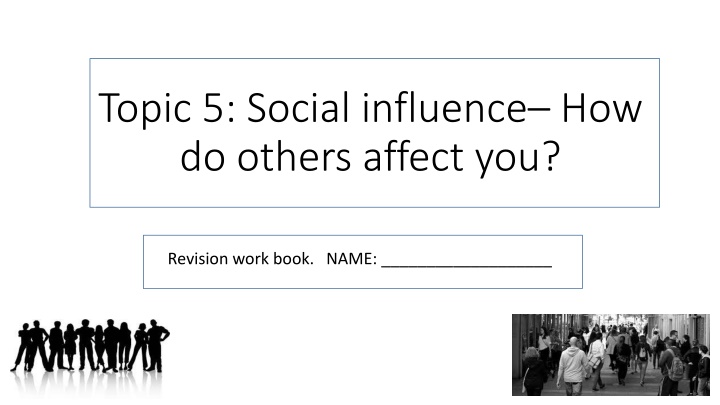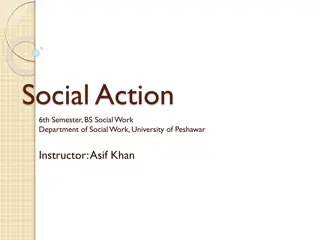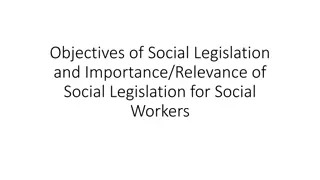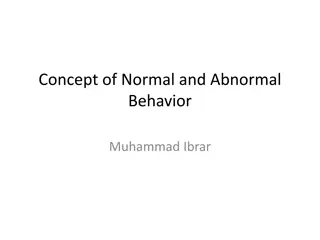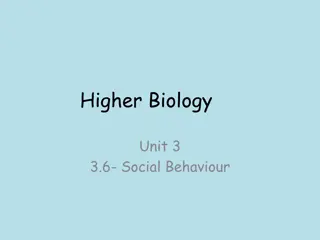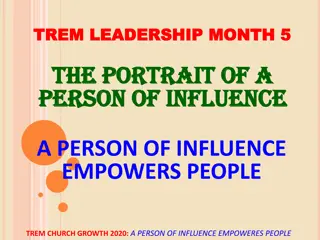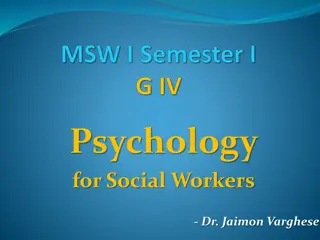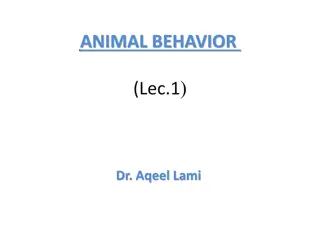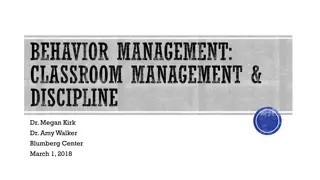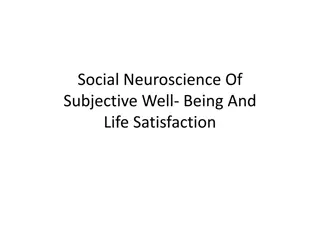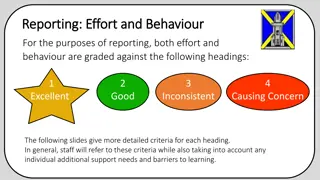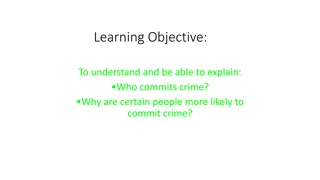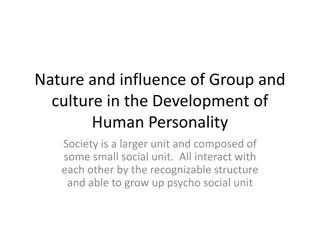Social Influence: How Others Shape Behavior
Explore the intricate ways in which social influence impacts our behavior, from conformity to obedience, and the bystander effect. Learn key terms associated with social influence and how to prevent blind obedience to authority figures. Delve into case studies and real-life examples to deepen your understanding of this fascinating psychological phenomenon.
Download Presentation

Please find below an Image/Link to download the presentation.
The content on the website is provided AS IS for your information and personal use only. It may not be sold, licensed, or shared on other websites without obtaining consent from the author.If you encounter any issues during the download, it is possible that the publisher has removed the file from their server.
You are allowed to download the files provided on this website for personal or commercial use, subject to the condition that they are used lawfully. All files are the property of their respective owners.
The content on the website is provided AS IS for your information and personal use only. It may not be sold, licensed, or shared on other websites without obtaining consent from the author.
E N D
Presentation Transcript
Topic 5: Social influence How do others affect you? Revision work book. NAME: ___________________
The Big Picture. You should have learnt about Notes complete or X RAG Action The key terms associated with social influence Factors that affect bystander intervention Factors that affect conformity to majority influence Factors affecting obedience to authority figures How conformity and obedience influence crowd behaviour Ways to prevent blind obedience to authority Social influence studies by Piliavin et al. (1969) and Haney, Banks and Zimbardo (1973) Issues and debates around social and cultural issues in psychology Red Insecure or incomplete I could not answer an exam question on this subject Amber Emerging I could have a go at an exam question on this subject but would probably miss some details and therefore lose some marks. Green Secure/confident I could answer an exam question on this subject and achieve full Marks
Obedience Terms used in Terms used in social influence social influence research research Conformity Compliance explained by normative social influence Key terms: Obedience Internalisation explained by informational social influence Authority figure Conformity Compliance Normative social influence Identification Internalisation Informational social influence Deindividuation Identification Deindividuation
Apply it Apply it Complete the table with the correct term for each description. (3 marks) A group of friends were shown images of how our meat is produced in school. Some did not like the way meat is produced and thought meat processing was unkind to animals. As a result, Olwyn and her friends decided to become vegetarian. Amanda went along with her friends and became a vegetarian, too, but secretly she still wanted to eat meant. Description Term Although Elliot preferred classical music, he listened to pop music with his friends because they liked it. Using your knowledge of types of conformity, explain Olwyn and Amanda s behaviour. (3 marks) Louis saw a person stumble and fall in the street. He thought they must be drunk so he did not stop to help. When Carolyn put on her police uniform for work she could not be her usual silly and fun-loving self because she was expected to act as a police officer would.
In 1964, a young woman called Kitty Genovese was brutally murdered outside her New York apartment. Although there were many witnesses to the event, none immediately stepped in to help her. Bystander effect Key terms: Bystander effect Psychologists Bibb Latane and JohnDarley explained this as bystander effect (sometimes called bystander apathy) as people s reluctance to help is because they believe others will help instead. We also look to others to see how to behave, so if no-one else is helping, we will not help either.
Bystander intervention Situational factors affecting bystander intervention Personal factors affecting bystander intervention Diffusion of responsibility.. Competence Key terms: Situational factors Personality factors Diffusion of responsibility Noticing the event Mood Pluralistic ignorance Whether we choose to help someone in need or not is dependent on many factors that can be broadly defined as situational and personal. Situational factors are features of a situation that influence how likely we are to intervene in an emergency. Personality factors are features specific to us (e.g. traits, abilities or feelings) that influence whether we help or not Pluralistic ignorance Similarity Cost of helping
Apply it Jerome was shopping in a busy high street when he saw what he thought was a drunken person collapse in the street. Jerome walked past and did not help. Using your knowledge of situational factors that influence bystander intervention, explain why Jerome failed to help. (3 marks) Psychology in action Understanding bystander behaviour is very important as it can be used to help prevent bullying. Most bullying occurs when adults are not around, so educating children to intervene to prevent bullying can be really useful. Anti-bullying programmes suggest that children are educated to intervene by understanding the following: Children should be encouraged to tackle bullying by taking responsibility in a situation and offering help. Children need to understand that it is their responsibility to act rather than wait for someone else to do so. Children should be encouraged to empathise and understand how it feels to be bullied so that they can feel a connection to the person being bullied. Children should feel confident that if they intervene it will have a positive outcome and will not negatively impact on them personally.
Situational factors affecting conformity Personal factors affecting conformity Conformity Size of the majority Locus of control Key terms: Confederate Locus of control Internal locus of control External locus of control Unanimity of the majority Internal locus of control We conform when we match other people s beliefs and behaviours because we want to fit in or we do not know how to act in a situation. Some people are more likely to conform because of the situation they are in, and personality factors also determine whether a type of person is more likely to conform or not. Task difficulty/ambiguity External locus of control
Obedience refers to following the orders of an authority figure. This authority figure is typically defined by status, role and/or the ability to use sanctions. A parent can be described as an authority figure because they can remove your pocket money; a police officer has a role of authority recognised by their uniform; and a peer can have greater status in your friendship group. Obedience to an authority figure Key terms: Obedience is not necessarily a bad thing. We maintain social order by complying with orders, such as wearing school uniform or stopping at a red traffic light. However, some obedience can be considered bad because it may harm another person. Blindobedience occurs when we comply with the order of an authority figure without question. This may be harmful because we fail to reflect on whether our actions are appropriate and fail to take responsibility for such actions. Blind obedience Anti-Semitic Momentum of compliance During the Nazi regime in Germany, many soldiers committed acts of atrocity against millions of innocent Jews, Gypsies and persons that did not support the Nazi government. These soldiers were complying with the orders of their superior officers, often unquestioningly. No one would argue that blind obedience was the sole cause of anti-Semitic attitudes and the Holocaust, however, the soldiers blind obedience to authority was a contributory factor. To test the theory that ordinary people were capable of harming others on the orders of an authority figure, psychologist Stanley Milgram conducted a series of experiments. These experiments tell us a lot about the conditions under which we are more, or less likely to obey.
Situational factors affecting obedience to an authority figure other factors that influence obedience Proximity of the victim .. Proximity of the authority figure Authority figure Legitimacy of the context Personality factors affecting obedience Personal responsibility Support of others
Authoritarian personality The concept of the authoritarian personality came from research by Theodor Adorno et al. (1950). Adorno was attempting to explain the level of anti-Semitism and racism demonstrated by the Nazis during the Second World War. He believed that some people were more inclined to hold anti-Semitic attitudes than others, and that this type of person would display the following characteristics: Respect for authority figures Rigid beliefs and attitudes A strong belief in justice Right-wing politics Aggressive to those inferior to themselves Key terms: Authoritarian personality F-Scale Another personality factor that may influence obedience is the authoritarian personality. Someone with an authoritarian character tends to be respectful to authority, so is more likely to follow orders. Adorno developed a questionnaire called the F-Scale to test whether someone had an authoritarian personality. Milgram used this questionnaire in an obedience experiment to understand whether the obedient participants had an authoritarian personality and compared them to the disobedient participants. There were 40 participants tested using the F-Scale. The 20 obedient participants gained higher F-Scale scores than the 20 disobedient participants. Milgram concluded that the level of obedience from different participants could have been caused by their personalities.
Apply it Apply it A group of five students were given a class test on the capital cities of the world. A multiple-choice question asked for the capital city of Australia. The options were; Suki is conducting an obedience study. Participants are ordered to walk around a room and criticise people for not completing their jigsaw fast enough. They are ordered by a stern-looking teacher to continue to criticise and harass the people. Sydney Using your knowledge of situational factors that influence obedience , explain the likely findings of Suki s experiment. (6 marks) Canberra Brisbane The students discussed the answer and four of them decided to select Sydney as their answer. The fifth student was not sure, but decided that Sydney sounded about right. They all marked Sydney as their answer on the test. Using your knowledge of types of situational factors affecting conformity, discuss the choice made by the fifth student. (3 marks)
Understanding the behaviour of crowds Understanding the behaviour of crowds Deindividuation and conformity Obedience Key terms: Prosocial behaviour Antisocial behaviour There are many different types of crowd; some are peaceful and some are destructive. Peaceful crowds can be found at festivals, concerts and sporting events even protests can be peaceful. In such cases, crowds can show prosocial behaviour. However, some crowds can start off as, or develop into, mobs from which rioting can arise. In this instance, the crowd can be described as showing antisocial behaviour.
Apply it. Bessie conducted an experiment to investigate crowd behaviour. She asked individuals and small and large groups of people to decide how much hot sauce to give another person. The hot sauce was painful to taste. The results of her investigation are shown in table below: Type of grouping Amount of hot sauce Individual 10 mls Small group of 3 20 mls Large group of 10 35 mls Using your knowledge of obedience and conformity in understanding antisocial behaviour of crowds, explain Bessie s results. (4 marks)
Understand ways to prevent blind obedience to authority figures Ways to prevent blind obedience to authority Social support Milgram s research into obedience not only tells us when we are more likely to obey an authority figure, it also tells us when we are less likely to obey. In order to prevent blind obedience to authority, it is important to understand these factors and use this knowledge in society. Familiarity of the situation Distance Education
Apply it. Although aeroplane accidents are relatively uncommon, a review of accidents over a 10 year period found that the first officer not being willing to question a decision made by the captain contributed to more than 20 per cent of the accidents. Using your knowledge of ways of preventing blind obedience, explain how these accidents could be prevented in the future. (4 marks)
AIM Piliavin et al. (1969) Good Piliavin et al. (1969) Good Samaritanism: An Samaritanism: An underground underground phenomenon? phenomenon? PROCEDURE RESULTS CONCLUSION EVALUATION
Draw a storyboard to retell the research carried out by Piliavin et al. (1969) Good Samaritanism: An underground phenomenon?
AIM Haney, Banks and Haney, Banks and Zimbardo (1973) A study Zimbardo (1973) A study of prisoners and guards in of prisoners and guards in a simulated prison a simulated prison PROCEDURE RESULTS CONCLUSION EVALUATION
Draw a storyboard to retell the research carried out by Haney, Banks and Zimbardo (1973) A study of prisoners and guards in a simulated prison
Issues and debates Social and cultural issues in psychology Social issues in psychology Society refers to . A social issue is a . Key terms Society Social issue Culture Cultural issues in psychology Individualistic culture Collectivistic culture Culture refers to .. Individualistic cultures typically Collectivistic cultures typically
Social issues in psychology Cultural issues in psychology Obedience Conformity Deindividuation Bystander effect
Exam tip Exam style question Assess questions require extended writing, featuring full sentences and paragraphs to clearly separate out your ideas. Assess how culture influences group behaviour. Use concepts, theory and research from social influence in your answer. (9 marks) You should plan your answer before you start to make sure you do not leave out something important when you are writing. Group behaviour is quite open and can refer to conformity, crowd behaviour and bystander effect, so there is plenty of scope to refer to different explanations and theories. Remember to present an idea and where possible assess the research evidence or concept described. For this question, you will need to judge whether culture does actually have an influence on how we behave in groups, so a two-sided view would strengthen your answer.
Assess how culture influences group behaviour. Use concepts, theory and research from social influence in your answer. (9 marks)
Obedience Authority figure Conformity Compliance Normative social influence Internalisation Informational social influence Identification Deindividuation Bystander effect
Situational factors Personality factors Diffusion of responsibility Pluralistic ignorance Confederate Locus of control Internal locus of control External locus of control Blind obedience Anti-Semitic
Momentum of compliance Authoritarian personality F-Scale Prosocial behaviour Antisocial behaviour Field experiment Covert observation Ecological validity Demand characteristics Generalisability
Society Social issue Culture Individualistic culture Collectivist culture Key terms that are RED or AMBER for me and I need to concentrate on memorising them accurately:
